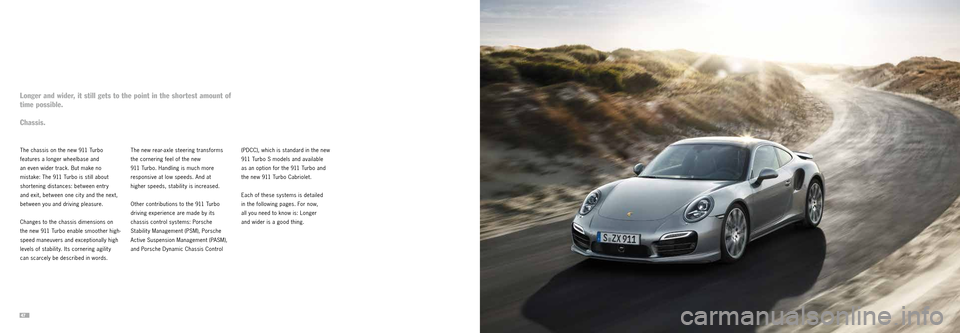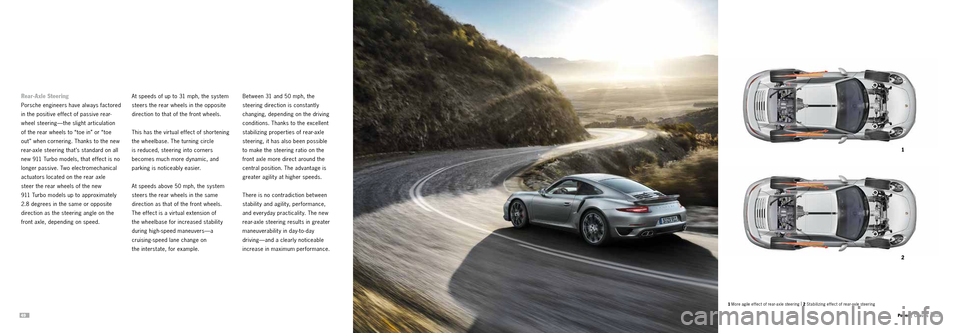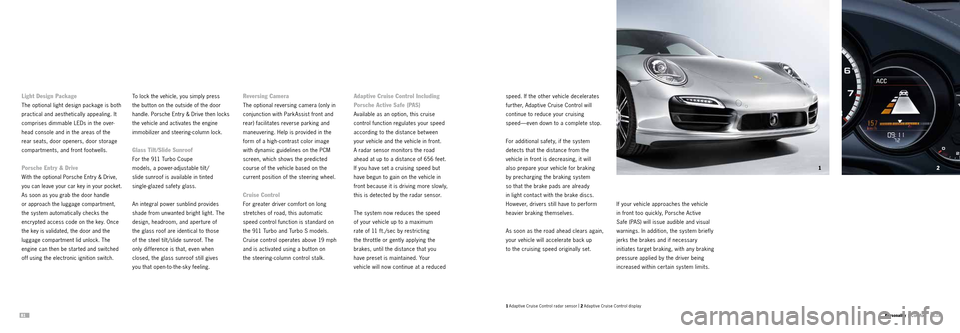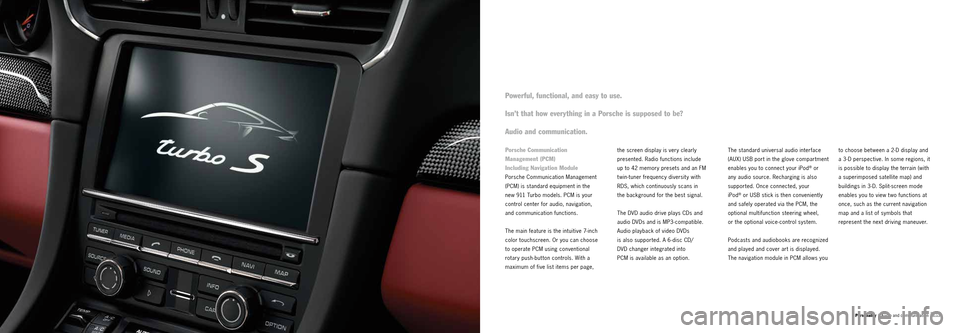steering PORSCHE 911 TURBO 2013 6.G Information Manual
[x] Cancel search | Manufacturer: PORSCHE, Model Year: 2013, Model line: 911 TURBO, Model: PORSCHE 911 TURBO 2013 6.GPages: 59, PDF Size: 5.96 MB
Page 23 of 59

4344 1 23
1 Digital and analog stopwatch mounted on the dashboard |
2 Spor t but tons in the center console |
3 Steering wheel display with PDK and Sport Chrono Package
Sport Button
Standard on all new 911 Turbo models,
the Sport but ton enables you to select
a suspension setup to emphasize either
comfort or sport y performance. At
the push of a but ton, the electronic
engine management system switches
the engine mapping to offer an even
sharper response. In conjunction with
the Sport Chrono Package (standard
in the 911 Turbo S and the new
911 Turbo S Cabriolet), the overboost
function is then active and the dynamic
engine mounts become much firmer.
In Sport mode, PDK ensures that
upshifts take place at higher engine
speeds and downshifts happen sooner.
Coasting mode and the Auto Start
Stop function are deactivated.
Sport Chrono Package Including
Dynamic Engine Mounts
The Sport Chrono Package including
dynamic engine mounts is standard in
the 911 Turbo S models and available
as an option for the new 911 Turbo. This
integrated system provides simultaneous
enhancement for the chassis,
including rear-axle steering, engine,
transmission, and aerodynamics.
The main features include a digital
and analog stopwatch mounted on the
dashboard, a performance display in the
Porsche Communication Management
(PCM) system, the Sport Plus but ton,
and the overboost function.
Activate Sport Plus mode and here’s what
happens: Porsche Active Suspension
Management (PASM), the electronic
suspension management, becomes more responsive. PASM and Porsche Dynamic
Chassis Control (PDCC)—standard in the
new 911 Turbo S—switch to Sport Plus
mode for a firmer suspension set ting,
more direct steering while cornering, and
increased roll stabilization. The rear-axle
steering also reacts more directly—for
even more agile steering. As part of
Porsche Active Aerodynamics (PA A),
the automatic adjustment of the front
and rear spoilers is also impacted in
the performance setting in Sport Plus
mode. So you can make full use of the
performance potential of your 911 Turbo.
In Sport Plus mode, the trigger threshold
for PSM is raised. Agilit y is perceptibly
enhanced when braking for corners with
PSM, allowing sportier braking and exit
acceleration. For maximum dexterit y, PSM
can be set to standby while the car
i
s
still in Sport Plus mode. Although, for
safet y, it ’s still there in the background. With the Sport or Sport Plus but ton
active, under full acceleration, the
maximum boost pressure in the
lower and medium speed ranges
is now temporarily increased by
approximately
2 psi: the overboost.
Engine torque is also boosted
by 37 lb.-ft. for a short time—to
524 lb.-ft. in the 911 Turbo and the
911 Turbo Cabriolet. In the 911 Turbo S
models, it goes up to 553 lb.-ft.
The Sport Chrono Package has t wo
additional functions. The first is
Launch Control, which helps achieve
optimal acceleration from a standing
start. The second function is the
motorsport-derived gearshift strategy.
Using this, PDK optimizes shift
points to the shortest possible shift
times for maximum acceleration.
Page 25 of 59

4748
The chassis on the new 911 Turbo
features a longer wheelbase and
an even wider track. But make no
mistake: The 911 Turbo is still about
shortening distances: bet ween entry
and exit, bet ween one cit y and the next,
bet ween you and driving pleasure.
Changes to the chassis dimensions on
the new 911 Turbo enable smoother high-
speed maneuvers and exceptionally high
levels of stability. Its cornering agility
can scarcely be described in words. The new rear-axle steering transforms
the cornering feel of the new
911 Turbo. Handling is much more
responsive at low speeds. And at
higher speeds, stabilit y is increased.
Other contributions to the 911 Turbo
driving experience are made by its
chassis control systems: Porsche
Stability Management (PSM), Porsche
Active Suspension Management (PASM),
and Porsche Dynamic Chassis Control
(PDCC), which is standard in the new
911 Turbo S models and available
as an option for the 911 Turbo and
the new 911 Turbo Cabriolet.
Each of these systems is detailed
in the following pages. For now,
all you need to know is: Longer
and wider is a good thing.
Longer and wider, it still gets to the point in the shortest amount of
time possible.
Chassis.
Page 26 of 59

4950
1
2
1 More agile ef fect of rear-axle steering |
2 Stabilizing effect of rear-axle steering
Power | Chassis
Rear-Axle Steering
Porsche engineers have always factored
in the positive effect of passive rear-
wheel steering—the slight articulation
of the rear wheels to “ toe in” or “ toe
out ” when cornering. Thanks to the new
rear-axle steering that ’s standard on all
new 911 Turbo models, that effect is no
longer passive. Two electromechanical
actuators located on the rear axle
steer the rear wheels of the new
911 Turbo models up to approximately
2.8 degrees in the same or opposite
direction as the steering angle on the
front axle, depending on speed. At speeds of up to 31 mph, the system
steers the rear wheels in the opposite
direction to that of the front wheels.
This has the virtual effect of shortening
the wheelbase. The turning circle
is reduced, steering into corners
becomes much more dynamic, and
parking is noticeably easier.
At speeds above 50 mph, the system
steers the rear wheels in the same
direction as that of the front wheels.
The effect is a virtual extension of
the wheelbase for increased stability
during high-speed maneuvers—a
cruising-speed lane change on
the interstate, for example.Bet ween 31 and 50 mph, the
steering direction is constantly
changing, depending on the driving
conditions. Thanks to the excellent
stabilizing properties of rear-axle
steering, it has also been possible
to make the steering ratio on the
front axle more direct around the
central position. The advantage is
greater agilit y at higher speeds.
There is no contradiction between
stability and agility, performance,
and everyday practicalit y. The new
rear-axle steering results in greater
maneuverability in day-to-day
driving—and a clearly noticeable
increase in maximum performance.
Page 28 of 59

5354
1
2 2
1 Fast cornering with the 911 Tu
rbo without PDCC (i llustration) |
2 Fast cornering with the 911 Tu rbo S w ith PDCC (illustration)
PDCC optimizes camber using
hydraulic stabilizing actuators in
the form of cylinders. Lateral roll is
counteracted by forces generated
at each individual wheel, based on
steering angle and lateral acceleration.
How does this translate to the
driving experience? More dynamic
performance with optimized turn-in and
stable load transfer characteristics.
And increased ride comfort. Porsche Stability Management (PSM)
All new 911 Turbo models come with
enhanced Porsche Stability Management
(PSM). It helps maintain stability
even at the limits of dynamic driving
performance. Sensors continuously
monitor the direction, speed, yaw
velocit y, and lateral acceleration of
the car. Using this information, PSM is
able to calculate the actual direction of
travel at any given moment. If the car
begins to oversteer or understeer, PSM
applies selective braking on individual
wheels to help restore stability.
Porsche Dynamic Chassis Control
(PDCC)
Porsche Dynamic Chassis Control (PDCC)
is standard on 911 Turbo S models and
available as an option on 911 Turbo
models. PDCC is an active anti-roll
system that suppresses lateral body
movement during cornering maneuvers
and helps minimize the lateral instability
of the vehicle on uneven ground. The
result is a car with improved roadholding
and more dynamic performance.
Under acceleration on wet or low-grip
road surfaces, PSM improves traction
using the Automatic Brake Differential
(ABD) and Anti-Slip Regulation (ASR).
When the Sport Plus mode of the
Sport Chrono Package is selected,
the PSM threshold is raised to allow
a more assertive driving st yle.
PSM can be deactivated. But for your
safety, it is automatically reactivated
only if you brake hard enough that
either of the front wheels (in Sport
Plus mode, both of the front wheels)
requires ABS (Anti-lock Brake
System) assistance. ABS and ABD,
however, remain active at all times.
1
Page 34 of 59

6566 Responsibility | Brakes
Sheet steel
Tailored blanks
Super high-strength steel
Ultra high -strength steel
Aluminum
Body
The innovative bodyshell of the new
911 Turbo models fulfills t wo structural
design requirements: first, excellent
driving dynamics due to the body’s
extremely high rigidit y. Second, a
savings in vehicle weight, primarily due
to its intelligent lightweight construction.
To meet the second requirement, we
employed state-of-the-art techniques
for combining various materials in order
to utilize specific material properties
exactly where they are needed.
Take the bodyshell, for example. It uses
very thin—but extremely rigid—sheets
of steel. Aluminum and magnesium
were utilized extensively in areas
including the roof, underbody, doors,
engine compartment, and luggage compartment lids. Magnesium, which
is a particularly lightweight material,
was also selected for the cockpit
and center console support beam.
Reducing the overall weight—i.e.,
improving the power-to-weight ratio—
translates directly into the aim of
increasing performance, whether
that ’s measured by the acceleration,
steering, or braking. And it ’s measurable
another way, too: at the fuel pump.
Reduced fuel consumption.
For the driver, reducing the weight
of the 911 Turbo results in a high
level of comfort as well. Vibration-
damping characteristics are
excellent and, compared to the
previous model, torsional stiffness
has increased up to 25 percent to
create even sportier handling.
Airbags and the Po
rsche Side Impact
Protection (POSIP) System
The airbag technology in the new 911 Turbo
models provides full-size driver and front-
passenger airbags, which are inflated in t wo
stages depending on the severit y and t ype
of accident. In less serious accidents, the
airbags are only partially inflated to help
minimize discomfort to the occupants.
Another standard feature is the Porsche
Side Impact Protection (POSIP) system.
This system comprises side impact
protection elements in the doors and t wo
airbags on each side, an integral thorax
airbag located in each seat side bolster,
and a head airbag contained in each of
the door panels. Knee airbags are also
standard on all 911 Turbo models.
Rollover Protection in the
Cabriolet Models
Despite their light weight, the 911 Turbo
Cabriolet models have exemplary
torsional rigidit y and flexural strength.
Body flexing is minimal, especially when
compared with driving most other open-
top sports cars on uneven road surfaces.
In the event of a 911 Turbo Cabriolet
model rolling over, additional protection
is provided by a supplemental safet y
roll bar protection system that deploys
automatically. The two spring-loaded
rollover bars are located behind
the back seats. The rollover sensor
continuously monitors the car’s pitch
and roll, lateral and longitudinal
acceleration, and contact with the road.
In an emergency, it deploys the rollover
bars within a fraction of a second.
Page 38 of 59

7374 1Personality | Comfor t
1 911 Turbo interior in Espresso
With the new 911 Turbo models, our
engineers have pushed forward into
the extreme performance range. The
fact that the driver can remain quite
composed is also due to the answers
they have found to the questions about
sportiness, ergonomics, and comfort.
Interior
A Porsche interior is never frivolous,
always direct. In the new 911 Turbo,
clever technology and clear operating
logic allow the driver to experience
all that makes this the benchmark for
Porsche performance, as evident at once
from the ascending center console. In t ypical Porsche fashion, the use of form
follows a basic principle: Focus on the
driver. It ’s why the distance bet ween
the gear selector and steering wheel is
extremely short, and the operating logic
of systems such as the dual-zone air
conditioning or the suspension is clear
and uncomplicated. You shouldn’t have to
browse one submenu after another. You
should instead be able to concentrate on
what ’s singularly important: the road.
Materials of high qualit y define the sport y
character of each 911 Turbo model.
The standard Leather package includes
Leather seats, dashboard, and door and
side trims. Alcantara
® has proven its
worth in motorsport and is now standard
for the roof liner on the Coupe models.
The exclusive two-tone interior in Black
and Carrera Red is reserved especially
for the 911 Turbo S models. Dashboard,
center console, and door panel trim
strips in Carbon are standard in these
models (available as an option for the
911 Turbo and 911 Turbo Cabriolet).
In addition to the choice of Black,
Platinum Grey, Luxor Beige, and Yachting
Blue for the interior, there is a wide range
of other personalization options available, including two-tone color combinations
or special colors and materials such as
Carbon, Aluminum, or high-quality Wood.
Engineering that takes you forward: the
Porsche Communication Management
(PCM) system with navigation module
and a high-resolution 7-inch color
touchscreen. PCM is your control
center for audio, navigation, and
communication functions. It’s fitted as
standard in the new 911 Turbo models.
Inside, yet another Porsche extreme:
extreme quiet.
Comfort.
Page 39 of 59

76 75
1234
Personality | Comfor t
1 Burmester® High-End Surround Sound System |
2 SportDesign steering wheel3 911 Turbo instruments |
4 SportDesign steering wheel with gearshif t paddles
Another way of set ting standards: sound.
The new 911 Turbo comes standard
with the Bose
® Surround Sound System.
Its total power output of 445 wat ts
provides outstanding performance.
The High-End Surround Sound System
from Burmester
® is available as an
option. Burmester
® is one of the most
respected premium audio manufacturers worldwide. With a total output of
821 wat ts, the High-End Surround
Sound System from Burmester
®
creates powerful reproduction and a
dynamic, three-dimensional sound.
SportDesign Steering Wheel
The SportDesign steering wheel is
a standard feature of the 911 Turbo
models. It is adjustable for both height
(by up to 1.5 inches) and reach (up to
2.25 inches) and, thanks to its grip
moldings, it ’s in safe hands— even on
the sportiest of drives. The steering
wheel features t wo gearshift paddles
made from a strong alloy. They are
ergonomically located behind the left- and right-hand steering wheel spokes.
Pull the right-hand paddle and PDK
shifts up. Pull the left-hand paddle
and PDK shifts down. Combined with
the optional Sport Chrono Package
(standard in the 911 Turbo S and
the new 911 Turbo S Cabriolet),
the left- and right-hand spokes also
include a display that tells you whether
Instruments
The five round instruments have
one purpose above all: to provide
information efficiently and accurately.
The five-gauge cluster is a signature
of Porsche design and, as always, the
large tachometer is in the middle.
The 4.6-inch, high-resolution TFT color
screen provides you with a continuous
stream of data from the onboard
computer, such as trip mileage or
average fuel consumption. It also
displays the navigation system map,
delivers various warnings, including
the Sport, Sport Plus, and Launch
Control functions are activated.
As an option, for no extra charge,
you can have a sport steering
wheel with multifunction buttons.alerts from the Tire Pressure Monitoring
System (TPMS), and reminds you of
your selected communication and
audio set tings. You can also use it to
carry out individual vehicle set tings.
Page 40 of 59

77
1
2
1 911 Turbo rear in Yachting Blue |
2 Adaptive Sport Seat Plus
shell is finished in Silver Grey (911 Turbo
models) or Leather (911 Turbo S models).
Rear Seats
The rear seats are remarkably
comfortable for a sports car. And the
shelf behind offers additional storage
space. With the backrests folded down,
the luggage compartment volume in
the 911 Turbo Coupe increases to
9.2 cubic feet, providing plent y of space
for luggage. You have 5.5 cubic feet in
the new 911 Turbo Cabriolet models.
Power Sport Seats
When it comes to seating, the goals of
high performance are t ypically at odds
with the desire for comfort. But the seats
in the new 911 Turbo manage to serve
both goals equally well. The Sport seats
that are standard in the new 911 Turbo
and the new 911 Turbo Cabriolet offer
full power adjustment of seat height,
backrest angle, seat cushion angle, and
seat cushion depth, as well as fore/aft
position, and four-way lumbar support.
The integrated memory package
supports the exterior mirrors and all
seat positions on the driver’s side as
well as set tings for the steering wheel,
lights, wipers, air conditioning, door
locks, PCM, and instrument cluster.
lateral support on winding roads.
Also included is the personal memory
for all seat positions (apart from the
side bolsters) and lumbar support
on the driver’s side as well as the
positions of the steering wheel and
exterior mirrors. The memory function
also supports set tings for the lights,
wipers, air conditioning, door locks,
PCM, and instrument cluster.
Sport Seats Plus
Available as an option, at no extra
cost, are Sport Seats Plus in Leather
with power seat height and backrest
adjustment as well as mechanical fore/
aft adjustment. The side bolsters on
the seat cushion and backrest have
a firmer, sportier padding and offer
excellent lateral support. The backrest
Adaptive Sport Seats Plus
For maximum sports performance,
Adaptive Sport Seats Plus are standard
in the new 911 Turbo S and the new
911 Turbo S Cabriolet. The firm, sport y
padding of the side bolsters and
additional shoulder supports provides
the best possible hold. And with 18-way
electric adjustment, the seats can be
optimally adapted to meet your needs
in terms of seat height, seat cushion
and backrest angle, seat cushion
length, fore/aft adjustment, and four-
way lumbar support. The steering
column is also electrically adjustable.
In addition, the side bolsters on the
seat cushion and backrest can be
adjusted independently for added
comfort on long journeys and precision
Child Seats
LATCH child seat preparation
including top tether is available
for the rear seats as standard.
Seat Heating and Seat Ventilation
Seat heating is available for all seats
as an option at no extra charge. Seats
are heated in the seat cushion, the
backrest, and, for the front seats,
the side bolsters. In conjunction with
seat heating, we can equip the seats
with seat ventilation on request. A slipstream effect is produced by active
ventilation of the perforated seat center
and backrest and by passive aeration
at the side bolsters. This evaporates
perspiration moisture and therefore
makes for a dry and pleasant seating
environment, even in hot weather.
Page 42 of 59

8182
12
Personality | Comfor t
1 Adaptive Cruise Control radar sensor |
2 Adaptive Cruise Control display
Light Design Package
The optional light design package is both
practical and aesthetically appealing. It
comprises dimmable LEDs in the over-
head console and in the areas of the
rear seats, door openers, door storage
compartments, and front foot wells.
Porsche Entry & Drive
With the optional Porsche Entry & Drive,
you can leave your car key in your pocket.
As soon as you grab the door handle
or approach the luggage compartment,
the system automatically checks the
encrypted access code on the key. Once
the key is validated, the door and the
luggage compartment lid unlock. The
engine can then be started and switched
off using the electronic ignition switch. To lock the vehicle, you simply press
the but ton on the outside of the door
handle. Porsche Entry & Drive then locks
the vehicle and activates the engine
immobilizer and steering-column lock.
Glass Tilt/Slide Sunroof
For the 911 Turbo Coupe
models, a power-adjustable tilt /
slide sunroof is available in tinted
single-glazed safety glass.
An integral power sunblind provides
shade from unwanted bright light. The
design, headroom, and aperture of
the glass roof are identical to those
of the steel tilt /slide sunroof. The
only difference is that, even when
closed, the glass sunroof still gives
you that open-to-the-sky feeling.
Reversing Camera
The optional reversing camera (only in
conjunction with ParkAssist front and
rear) facilitates reverse parking and
maneuvering. Help is provided in the
form of a high-contrast color image
with dynamic guidelines on the PCM
screen, which shows the predicted
course of the vehicle based on the
current position of the steering wheel.
Cruise Control
For greater driver comfort on long
stretches of road, this automatic
speed control function is standard on
the 911 Turbo and Turbo S models.
Cruise control operates above 19 m p h
and is activated using a but ton on
the steering-column control stalk.
Adaptive Cruise Control Including
Po
rsche Active Safe (PAS)
Available as an option, this cruise
control function regulates your speed
according to the distance bet ween
your vehicle and the vehicle in front.
A radar sensor monitors the road
ahead at up to a distance of 656 feet.
If you have set a cruising speed but
have begun to gain on the vehicle in
front because it is driving more slowly,
this is detected by the radar sensor.
The system now reduces the speed
of your vehicle up to a maximum
rate of 11 f t . /s e c by restricting
the throt tle or gently applying the
brakes, until the distance that you
have preset is maintained. Your
vehicle will now continue at a reduced speed. If the other vehicle decelerates
further, Adaptive Cruise Control will
continue to reduce your cruising
speed— even down to a complete stop.
For additional safet y, if the system
detects that the distance from the
vehicle in front is decreasing, it will
also prepare your vehicle for braking
by precharging the braking system
so that the brake pads are already
in light contact with the brake discs.
However, drivers still have to perform
heavier braking themselves.
As soon as the road ahead clears again,
your vehicle will accelerate back up
to the cruising speed originally set.
If your vehicle approaches the vehicle
in front too quickly, Porsche Active
Safe (PAS) will issue audible and visual
warnings. In addition, the system briefly
jerks the brakes and if necessary
initiates target braking, with any braking
pressure applied by the driver being
increased within certain system limits.
Page 43 of 59

8384 1Personality | Audio and communication
Powerful, functional, and easy to use.
Isn’t that how everything in a Porsche is supposed to be?
Audio and communication.
Porsche Communication
Management (PCM)
Including Navigation Module
Porsche Communication Management
(PCM) is standard equipment in the
new 911 Turbo models. PCM is your
control center for audio, navigation,
and communication functions.
The main feature is the intuitive 7-inch
color touchscreen. Or you can choose
to operate PCM using conventional
rotary push-but ton controls. With a
maximum of five list items per page, the screen display is very clearly
presented. Radio functions include
up to 42 memory presets and an FM
twin-tuner frequency diversity with
RDS, which continuously scans in
the background for the best signal.
The DVD audio drive plays CDs and
audio DVDs and is MP3-compatible.
Audio playback of video DVDs
is also supported. A 6-disc CD/
DVD changer integrated into
PCM is available as an option.
The standard universal audio interface
(AUX) USB port in the glove compartment
enables you to connect your iPod
® or
any audio source. Recharging is also
supported. Once connected, your
iPod
® or USB stick is then conveniently
and safely operated via the PCM, the
optional multifunction steering wheel,
or the optional voice-control system.
Podcasts and audiobooks are recognized
and played and cover art is displayed.
The navigation module in PCM allows you to choose bet ween a 2-D display and
a 3-D perspective. In some regions, it
is possible to display the terrain (with
a superimposed satellite map) and
buildings in 3-D. Split-screen mode
enables you to view t wo functions at
once, such as the current navigation
map and a list of symbols that
represent the next driving maneuver.